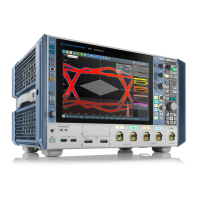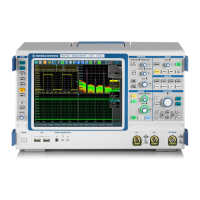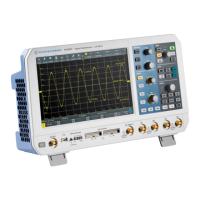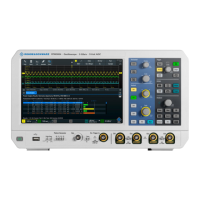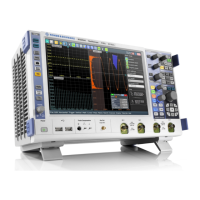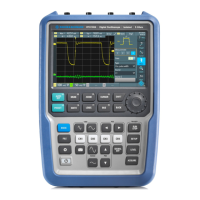Spectrum analysis
R&S
®
RTE
402User Manual 1326.1032.02 ─ 20
●
FFT -dφ*df (group delay): the negative derivative of the phase with respect to fre-
quency; useful to measure phase distortion
9.1.2 Configuring spectrum waveforms
During FFT analysis, a signal in the time domain is converted to a spectrum of frequen-
cies. A basic spectrum waveform can be displayed quickly. By defining additional FFT
parameters, the waveform can be configured in more detail.
As a result, either the magnitude or the phase of the determined frequencies can be
displayed, or more complex FFT functions. Analysis can be restricted to an extract of
the original time base, and the results display can be restricted to a specified frequency
range.
To display a basic spectrum waveform using the toolbar
1. Tap the "FFT" icon on the toolbar.
2. Tap the waveform for which the FFT is performed.
The first available math waveform is configured to use the selected waveform as a
source and the "Mag(FFT(x))" operator, and is enabled. The spectrum waveform is
displayed in a new diagram.
To display a basic spectrum waveform using the [MATH] key
1. Press the [MATH] key to open the "Math" dialog box.
2. In the "Setup" tab, in the "Basic" editor, select the input signal as "Source 1".
3. Select "Mag(FFT(x))" as the "Operator".
4. Select the "Enable math signal" icon.
5. If necessary, edit the spectrum waveform parameters as described in the following
procedures.
To display advanced spectrum waveforms
In "Advanced" math definition mode, other FFT results than the basic frequency magni-
tude can be displayed.
1. In the "Setup" tab of the "Math" dialog box, select the "Advanced" expression edi-
tor.
2. Double-tap the edit area.
The "FormulaEditor" is displayed.
3. Delete the contents of the edit field.
4. Tap the "More" key to display further functions in the editor.
5. Tap the required FFT function key.
FFT analysis
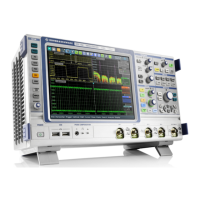
